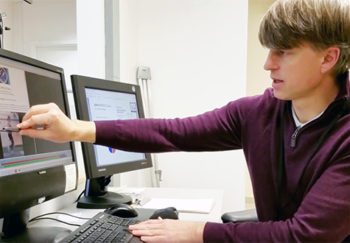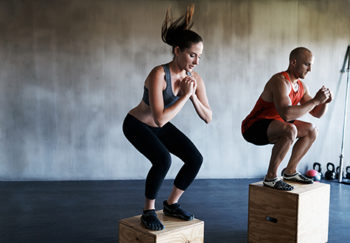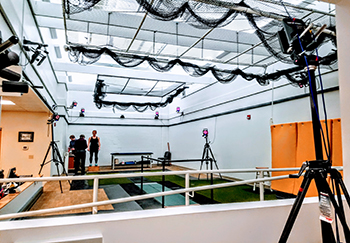
Back in October, my friend and colleague Amy Sarah Marshall encouraged me to train with her for the Charlottesville Ten Miler race. I was excited to commit to the training, but also nervous. While I was already doing a good bit of running on my own, I’d been slowly recovering from a flare-up of an old back injury. I ruptured a disc and injured my right sacroiliac joint falling from a horse 10 years ago. I’ve had to be careful about the types and intensity of activity ever since.
I didn’t know what the additional distance and presumably increased speed of training for this race might do to my injury. So, when I had the opportunity to have a running gait assessment done at the UVA Speed Clinic, I jumped at the chance. Heading into my appointment, I hoped to learn three main things:
- Whether or not my back injury could safely handle the stress of increased mileage
- Whether running should be a part of my fitness routine at all, because of my back injury
- If I needed to make any changes to my form in order to run injury-free
As Amy Sarah detailed yesterday on the blog, the Speed Clinic is an incredibly high-tech place. The team measures runners’ mechanics, looking for their strengths as well as inefficiencies. In many cases the team, aided by incredible technology, can identify the source of injury that has eluded doctors and physical therapists. From there, the team can recommend strengthening exercises, changes to a runner’s form and even the best types of running shoes for the athlete.
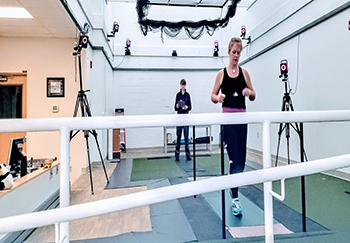
Preparing for the Running Assessment
The team let me know that I should wear my normal running shoes to my appointment as well as fitted shorts or pants and tank top, since they would be applying reflective markers all over my body for the assessment.
The team had me complete a questionnaire as soon as I arrived. It asked about my athletic and injury histories, as well as details about my current training. Interestingly, the team prefers not to review this information prior to the assessment! Rather than be influenced by the information on the questionnaire, they like to see what they can figure out on their own by watching the runner’s mechanics and interpreting the data the system collects.
Next, the team had me step up on a stool where they applied 21 reflective markers to my body. My shoes, calves, knees, spine, quads and chest were all covered. Finally, they wrapped a few bands of fluorescent pink tape around my waist. This would help them see any tilt to my hips as I ran.
Once the reflectors were on, it was time to run. There is a treadmill in the floor in the assessment room, and the room is surrounded by infrared cameras, which record the movements of the reflectors. Then, using a few other inputs like height, weight and leg length, the treadmill collects data on the forces of my stride and at specific joints.
The Running Analysis
The team had me start out just walking, to get a feel for the treadmill. Then they set the treadmill to my normal running pace and the assessment began. I ran for just 5-10 minutes. That’s all the data they need to accurately calculate each element of the runner’s stride.
Max Prokopy, head of the clinic, watched and took notes as I ran, while the cameras recorded video and began feeding data into the computer system. After the run, Prokopy took me through a few floor exercises to test my flexibility, strength (squats) and balance (standing on one foot with my eyes closed).
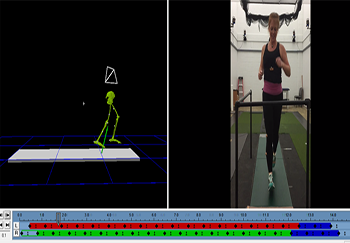
Reviewing the Results
Once we wrapped up the exercise and data collection processes, the team took a few minutes to run the data through their system and create the 3D rendering of me. And this is where the gait analysis got really cool.
The Customized Movement Analysis Animation
At this point, we sat down together, and Prokopy introduced me to the customized, animated version of me. It’s almost like a video game. I had been transformed into a digital skeleton of green and red lights – literally, the bare bones of the physics at work in my body as I run. It’s frankly amazing.
Prokopy hit play, and the stick figure of me began running alongside the video of me running. He could speed up the animation or change the angle, so we could see the forces around my body. As the animation moved, red and green arrows lengthened and shortened, indicating the direction and magnitude of the forces as I ran.
This is where the team could start comparing the forces on each side of the body, looking for inefficiencies or causes of injury. To do this, the team looked at charts and charts of data about my overall mechanical efficiency, braking force, cadence and propulsion.
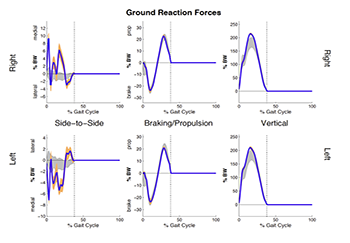
The Motion Analysis Results
Prokopy quickly tells me that even though we’ll go over some things to make me a faster, more efficient runner, he is clearing me to run as much as I want. There are no serious mechanical issues that are going to put my back injury at risk, and that’s a big relief.
He tells me, “There’s a lot to like about how you run. You run within yourself, you’re comfortable with what you’re doing, running along naturally, a good rhythm and flow to it.”
Prokopy gave several highlights about the mechanics of my running.
My static balance is very good.
Lots of factors affect this, but it’s possibly due to my history of athletics and routine yoga practice.
My foot lands pretty much right under my body.
That’s a good thing. Over-striding (foot landing way ahead of body) can lead to injury.
My back injury shows up in how I run.
We watch the pink band around my waist on the running analysis video. It stays level at first, but as I stride with my left foot, it dips down on one side and I develop a pretty substantial arch in my back. The same does not happen during the same part of my stride on the other side.
Prokopy explains, “As you stabilize, look at the position of your core and trunk. As you push off, you lose your posture. I have no interest in changing it. It’s fine; it’s stable. You’re protecting the joint and compensating for the injury by over-striding slightly with your left leg, but you’re controlling yourself.”
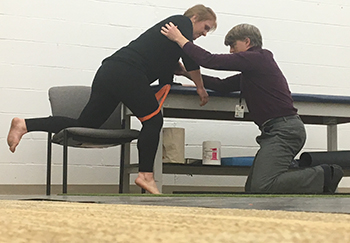
I roll my right foot across the ground differently and less efficiently than my left.
This is something we’ll work to improve with strengthening exercises, because it can make me faster. Also, Prokopy says this plus other pieces of the assessment make me a good candidate for minimalist (very lightweight, thin-soled) running shoes.
I can improve my speed by one minute per mile.
This is huge. I currently run about nine and a half minutes per mile over a ten-mile distance. Dropping that to eight and a half sounds hard to believe, but the prospect is exciting. Prokopy says that by increasing the efficiency of my foot strike with those exercises, switching to minimalist shoes, and perhaps upping my cadence (steps per minute) slightly, I can improve my running time tremendously.
What I Took Home
- A USB drive. It has all the graphs, the running report and even the animated skeleton of my running. This information can all be helpful for a runner to share with a doctor or physical therapist if they’ve been dealing with an injury.
-
Interested in Getting Your Own Running Evaluation?
Contact the Speed Clinic.
- Two exercises to strengthen my right foot and retrain how I step off.
- Confidence! I’m relieved to know I’m not messing up this old back injury by running. I’m excited to implement the Speed Clinic team’s recommendations and see my speed improve.
